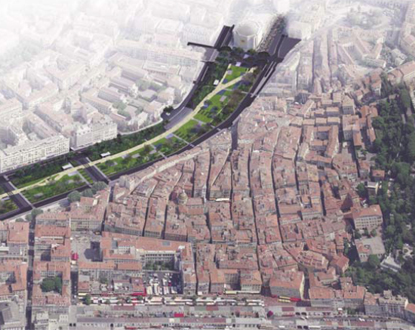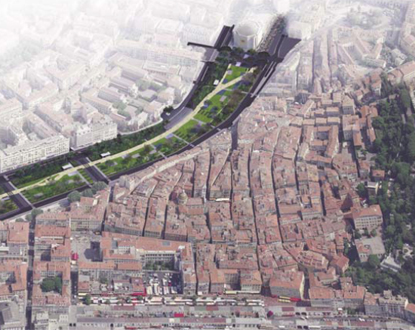During the 2008 municipal elections in Nice, the future mayor of the city, Christian Estrosi, promised some urban changes in the city of Nice. Today, in 2011, he is in office and a Local Urban Plan was voted on December 23, 2010. A closer look at the existing changes or lack thereof.

This contemporary theme appears to be the highlight of the project since, according to the deliberations of the session on December 23, 2010, it aims to “promote an innovative ‘eco-territory’ model to make Nice the Green City of the Mediterranean.”
It is organized around four founding themes:
- Preserve and enhance an exemplary landscape and environment
- Live and live together
- Improve mobility and alternative transportation
- Establish Nice as an international metropolis
Note that this plan concerns the entire commune of Nice, except for Vieux Nice, which has been protected by a Preservation and Enhancement Plan since December 1993.
An urban plan that can be linked to similar promises made by the current Mayor, Christian Estrosi, during his 2008 municipal election campaign. At that time, the politician presented his program aptly titled “100 actions for 10 challenges,” which promised numerous changes in the city.
On the agenda
Among the larger-scale projects found in Christian Estrosi’s 2008 program is the construction of a large stadium to the west of the city.
The project has been realized as the construction of the Nice Stadium will begin in August 2011, which will also host matches for UEFA Euro 2016.
Christian Estrosi’s program also promised a new port to the west of the Nice coast, a promise with mixed results this time. No new port has been developed yet, the existing one has simply been renovated. The project is contentious, and discussions are expected to be lengthy, as residents of the west part of the city are not in favor of such a change.
A project that has not come to fruition is the establishment of a new international exhibition center, a new Congress, to complement the current Acropolis. However, the Apollon hall at Acropolis has been completely renovated, almost equivalent to a new addition.
What the Local Urban Plan brings, some examples
The Local Urban Plan voted in 2010 brings with it a multitude of new projects. These projects, decided and affirmed by a vote, have gradually started since early 2011.
The most significant are undoubtedly the construction of a second tram line running from east to west across the city. After endless talks, we know that this T2 line will run from the airport to the port of Nice and will be partially underground. Thus representing a large-scale undertaking.
Another major project is the Green Corridor. A large 12-hectare green space that will run through the city following the Paillon River up to the mouth of the Var, from the Nice Theatre to the sea. For its construction, the bus station has already been demolished and relocated.
Moreover, the Urban Community has also been responsible for the renovation of certain neighborhoods in Nice that had been previously neglected: Pasteur, Notre Dame, Ariane, and Les Moulins. Altogether, more than 360 million euros will be spent.
These neighborhood projects stem from the “will of the Urban Community Council members for an urban and social reclamation of the most fragile territories. The objective is to sustainably improve the comfort and living conditions of inhabitants.”



